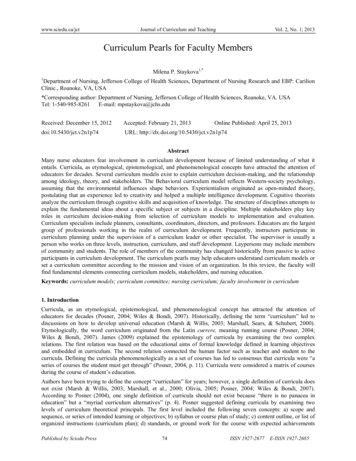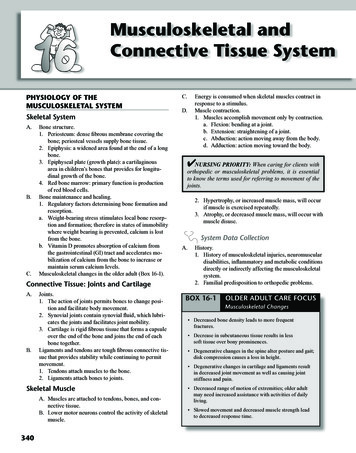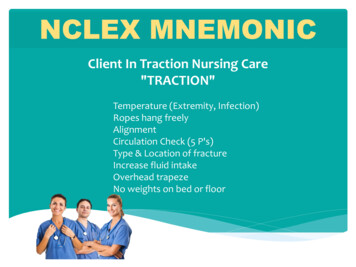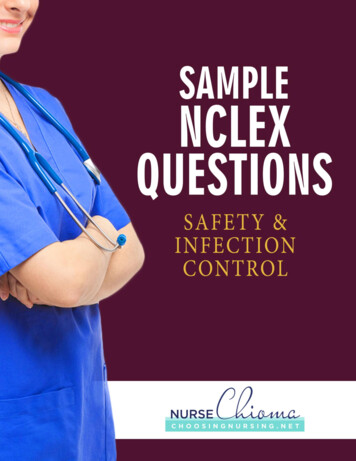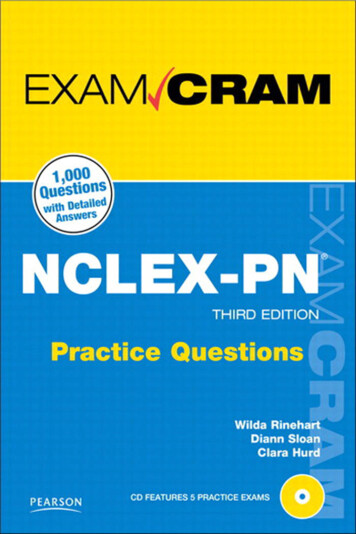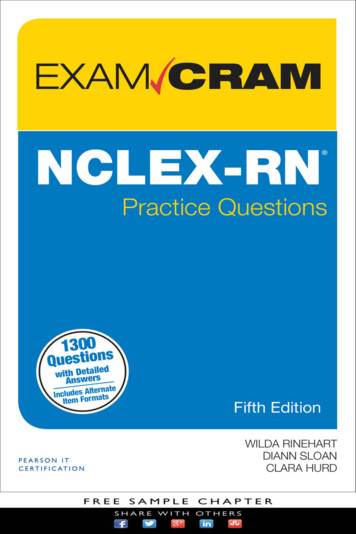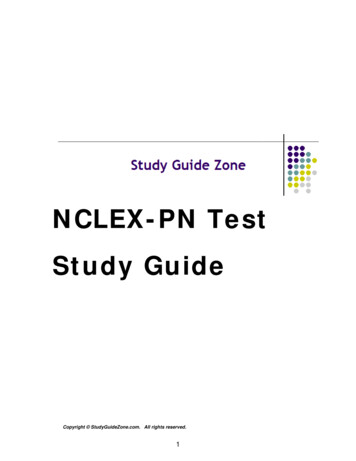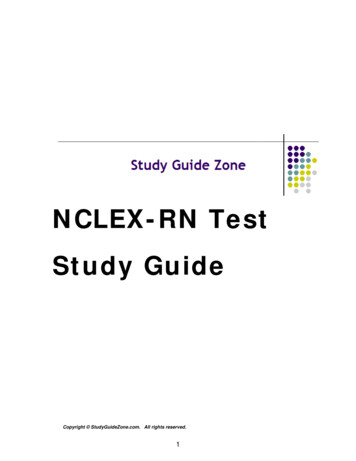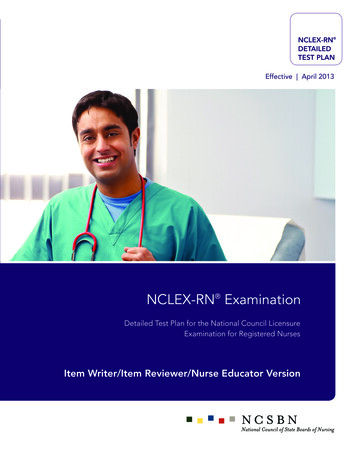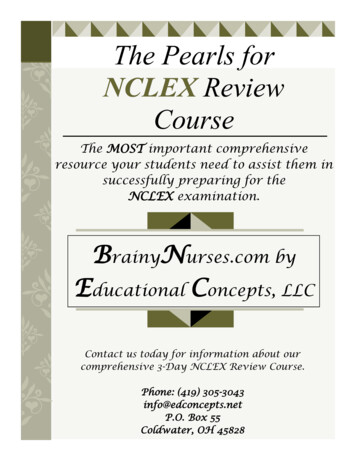
Transcription
The Pearls forNCLEX ReviewCourseThe MOST important comprehensiveresource your students need to assist them insuccessfully preparing for theNCLEX examination.BrainyNurses.com byEducational Concepts, LLCContact us today for information about ourcomprehensive 3-Day NCLEX Review Course.Phone: (419) 305-3043info@edconcepts.netP.O. Box 55Coldwater, OH 45828
The Pearls forNCLEX Review CourseEducational Concepts, LLCAuthor: Cynthia Liette MS, APRN, ACNS-BC, CCRNWelcome to The Pearls for NCLEX Review CourseThe Pearls for NCLEX Review is written by a long-term educator and clinician who recognizes theneed to teach in ways that enhance the retention of information. The course is designed for bothRN and PN students with specific content areas identified. It encompasses their entire nursingprogram and all the HESI and NCLEX review books and puts it into one manual of over 300 pagesand presented with over 1,200 visuals to enhance the retention of the material.The program is loaded with pathophysiology, pharmacology, lab abnormalities, diagnostics, andclinical correlation pieces. A review of the following is incorporated into this interactive seminar:***********Test taking hints* Professional developmentFundamental skills* Principles of nutritionMental health issues* Endocrine systemPulmonary system* Cardiovascular systemInfections in acute care* Renal & urological systemsAcid base overview & review* Musculoskeletal systemConnective tissue disorders* Neurological systemGastrointestinal system* Reproductive systemAccessory digestive organs* Maternity nursingPediatrics* Pharmacologic principles of med administrationLaboratory testing, normal and abnormal values for each systemWe invite you to preview our comprehensive review course which prepares students with test taking techniques and the knowledge to pass the NCLEX exam on their first attempt.The following pages includes excerpts from our program and highlights some of the teaching techniques used including fill-in-the-blank, group work, diagrams, fact-filled tables, “bubble hints”,pneumonics, and memory hints.We have also included student comments from the countless programs we have conducted to helpthem successfully pass their NCLEX Exam.Educational Concepts, LLCwww.brainynurses.com
The Pearls forNCLEX Review CourseAnswering Priority Setting QuestionsPrioritization is a key component of the exam. Students must know the order to assess patients when managing a team and they must be able to prioritize interventions. Areas reviewed include Key words, Maslow,ABCDs, triage, nursing process, and at risk patients. Numerous questions are then presented to enhance theuse of these concepts.Key Words are used frequently to make the student think“priority” and what to chose first. These may mediateBestPriorityMaslow’s Hierarchy may be used to determine priority.Physiologic and safety needs must be met first. Physiologic: Need for food, shelter, water, sleep, oxygen, and sexual expression. Safety: Avoiding harm, having security and order,and physical safety. Love and belonging: Giving and receiving affectionand companionship, identification with a group, respect of others, self esteem, and success in work. Self-actualization: Fulfillment of potential.ABCD’s is frequently used to determineassessment and intervention priorities. Airway Breathing (and oxygen) Circulation is assessed by checking:and Disability is assessed by checking:Student Comment: “Excellent instructor. Very knowledgeable withgood tips to help remember everything and great clinical examples toreinforce knowledge.”Educational Concepts, LLCwww.brainynurses.com
The Pearls forNCLEX Review CourseTriage: Think of a stop light to determine which patients to see andtreat first. Red: Critical patient. Stop and treat them immediately. Yellow: Could be seriously ill. Caution in assessment. Treat themin 30-60 minutes. Green: Go ahead and move to the next patient. See in a few hours. Black: Dead or dying.“Treat those who are salvageablefirst” in triage situations.Nursing Process to determine what to do first and how to proceed. Assessment and data collection are priority unless the patient is criticaland then an intervention may be needed. Establish the nursing problem using Maslow. Plan and implement interventions using ABCD. Evaluate the response or outcome. Notify the physician when: There is a complication or critical development They are not progressing like they should beAt Risk Patients to determine priority for assessment and interventions Procedures or injuries to vascular organs bydetermining mechanism of injury, organ location and clinical manifestations demonstrated: Determining patients who are unstable with theidentification of key clinical signs:Educational Concepts, LLCwww.brainynurses.com
The Pearls forNCLEX Review CourseDiverse Teaching StrategiesVarious teaching strategies are used throughout the program to enhance student involvement and comprehension to keep them engaged. All conditions and disorders are reviewed using a pathophysiologicapproach with more than 1,200 visuals to assist in understanding the disease process. Bullet points andconcise definitions allow for quick review and better retention of material covered.Chronic Renal Failure:A chronic and progressive condition where renal function is lost. Thosewith end stage renal failure require dialysis to live. Renal failure is a GFR 15% to 29%. End-stage is GFR 15%.Uremia or azotemia: High BUN and creatinine levels from protein metabolism. Will be seen in end stagerenal failure. Must restrict protein in these patients. GFR is the most reliable indicator of the level of proteinconsumption.Lab abnormalitiesK pH and HCO3PhosphorusSodiumMagnesiumBlood sugarCalciumAlbumin levelsRBCProtein in urinePT, PTTUric acidQuiz Time!What do you remember aboutlabs and renal failure?Work with a partner to comeup with the answers.Clinical manifestations of renal failure are related to four pathological processes: Anemia Accumulation of waste products Fluid retention Suppression of the immune systemThink about these pathological processes andhow they will manifest in your patients.Then review the complete table included for you.Student Comment:“The practice questions helped to identify tips to rule outanswers. Very helpful acronyms and pneumonics.”Educational Concepts, LLCwww.brainynurses.com
The Pearls forNCLEX Review CourseClinical Manifestations of Chronic Renal Failure:Skin changes Gray-bronze or yellow skin Pallor related to anemia Uremic frost Pruritis Excoriations Ecchymosis and purpura Thin, brittle nailsGastrointestinal Metallic or ammonia taste and breath odor Stomatitis Increase dental caries Anorexia Increased gastric acid Diarrhea or constipation May develop hepatitisCardiovascular Hypertension Acceleration of ASHD Increased risk of AMI and CVA Heart failure Pericarditis Pericardial effusion Cardiac dysrhythmiasCentral nervous system Memory problems Mental clouding which may progress toconfusion Flat affect Depression Irritability Stupor and coma SeizuresRespiratory Thick sputum, depressed cough Uremic breath odor Kussmaul’s respirations Pleural effusions Increased risk of pneumoniaPeripheral nervous system Neuropathies Loss of motor function Foot drop “Burning feet” syndromeAutonomic nervous system Poor blood pressure control Orthostatic hypotensionReproductive Impotence in men Decreased libido Amenorrhea Infertility in womenHematologic Anemia Platelet dysfunction Suppressed immune systemMusculoskeletal Impaired mobility Loss of muscle mass Osteomalacia OsteoporosisStudent Comment:“The course is straight to the point and everything Ineeded to review is in one resource book.”Educational Concepts, LLCwww.brainynurses.com
The Pearls forNCLEX Review CourseBullet Points & Bubble HintsBullet points are used throughout to give students a quick and easy way to remember clinical manifestations and treatments. Bubble hints are used to provide fun ways to remember facts.Post-Operative Complications:Work together with a partner and identify which conditions in the box are early and late complications.Early complications:Late complicationsPossible ComplicationsHypoxiaPulmonary embolusAtelectasisPneumoniaHypovolemic shockProblems with the woundIleusAtelectasis is complete or partialcollapse of the lung. Normal perfusionbut decreased ventilation. Stasis of secretions leads to bacterial growthand pneumonia.* Develops 24-48 hours postoperativelyClinical Manifestations Dyspnea Tachypnea Tachycardia Fever Decreased breath sounds Asymmetrical chest movement Increased restlessnessInterventions Cough & deep breathe &incentive spirometry Suction if necessary Medicate for pain Ambulate and frequent positionchanges BronchodilatorsStudent Comment:“Fantastic class! It moved along quickly with the material which is well detailedin the book. Loved the fill-in-the-blank areas to keep our attention and spontaneous group activities to change the pace of the class.”Educational Concepts, LLCwww.brainynurses.com
The Pearls forNCLEX Review CoursePneumoniaDeep Vein ThrombosisClinical ManifestationsClinical ManifestationsTachypneaShallow respirationsCracklesProductive coughHypoxiaAsymmetrical chest movementFeverLeukocytosisTachycardiaUnilateral swellingPain in the legPossible rednessPulmonary EmbolismHypovolemic ShockClinical ManifestationsTachypneaTachycardiaWeak pulseCool, clammy skinRestlessDecreased urine outputIncreased bleedingThirstDecreased CVPHypotensionClinical ManifestationsTachypneaTachycardiaIncreased anxietyDyspneaChest painBlood tinged sputumDiaphoresisDecreased orientationHypotension CO2 and O2 initially on ABGsStudent Comments:“This was an awesome class. Very knowledgeable instructor who really brought everything together for me.”“Amazing instructor! Easy to listen to and kept our (my)attention throughout the entire time!”Educational Concepts, LLCwww.brainynurses.com
The Pearls forNCLEX Review CourseProblems with the IncisionWound Dehiscence: Separation of incision.Type of incision most likely:Wound Evisceration: Evidence of bowel through the incisionwith increased pain. Those at risk include: Elderly DiabeticEmpty out with ObeseEvisceration Malnourished Prolonged paralytic ileusWound Infection Incisions will be red due to inflammation. Red with purulent drainage means a local infection which is usually staph or strep. Elevated WBC and fever indicates a systemic infection.“Quick-and Dirty” MethodsStudents appreciate the easy ways to remember numerous facts and conditions using “Quick &Dirty”. The hints are used for retention of information for the exam and readily transferred into theclinical environment for easy retention and application to practice.Vital Signs in Pediatrics: In the pediatric population, respiratory and heart rates must be measured.Age 0Document the child’s behavior with vital signs such as crying, febrile, orother distress. Use the table on the right to remember “ballpark” normalsfor the age groups:AgeRespPulseQuick & Dirty NormalsAdult20Around80To remember the normals, think 20, 30,40. Then remember breaths to heart rateis 1:4.Child30Up to120Infant40Up to160Educational Concepts, LLCwww.brainynurses.com
The Pearls forNCLEX Review CourseAcid Base ImbalancesCan use R-O-M-E for interpretationR Respiratory pH PCO2 Respiratory AlkalosisO OppositepH PCO2 Respiratory AcidosisM MetabolicpH HCO3 Metabolic AlkalosisE EqualpH HCO3 Metabolic AcidosisCan also use“Quick and dirty”for interpretation:“If the pH and Bicarbonateare Both in the same direction, then it is a metabolicproblem.”Sample #1:Sample #2:pH 7.38PaCO2 40HCO3 24pH 7.10PaCO2 35HCO3 15PaO2 62O2 Sat 70%Interpretation:Interpretation:Potassium effects inacid-base imbalancesStudent Comment:“Presented a lot of easy ways to rememberpoints. Great layout of information and verymuch to the point. I will keep this material for along time to go back and reference from andstudy.”Educational Concepts, LLCwww.brainynurses.c0mAdditional considerations:Check the electrolytes.Potassium will beImmediate intervention:
The Pearls forNCLEX Review CourseExtensive Lab ReviewA comprehensive review of labs and “need to know” values is incorporated throughout the program.Values are given in ‘ball park’ ranges to help the student remember the normals. Lab ‘tid-bits’ are givento understand relationships and how they are affected in disease conditions. Lab abnormalities withdisease pathology are reinforced throughout the course.Labs to evaluate dehydration and renal functionBUN: Normal is 10-20. Not a great indicator of renal function. Will be high inrenal dysfunction in conjunction with the creatinine. Used more often to evaluate dehydration.Creatinine 1.2 Value decreased in liver dysfunction because BUN 10-20the liver can’t make BUN.BUN : Ct ratio 20:1indicates renal failureCreatinine 1.2. Increases in renal failure.Hemoglobin: 12-18 (a dozen to a dozen and a half)Hematocrit (Hct): 36-54 (three times the hemoglobin)Specific gravity of urine: Normal is 1.005-1.030. High values indicate dehydration. 1.020 indicates hypovolemia and need for early intervention.Sodium: Normal is 135-145. Increases with dehydration.Student Comments:Lab tid bits and rulesNa and K exchange for one anotherK and H exchange for one anotherNa and Cl- are buddiesCa and Mg run together and HPO4 isopposite in the absence of diseaseK runs with Ca and Mg “Labswere thoroughly coveredand then reviewed throughout thecourse. I have a much better understanding of them than ever before.”“Thank you for the Lab ReviewCard given during the course. Veryhelpful for remembering the valuesand diagnostics.”Educational Concepts, LLCwww.brainynurses.com
The Pearls forNCLEX Review C
The Pearls for NCLEX Review is written by a long-term educator and clinician who recognizes the need to teach in ways that enhance the retention of information. The course is designed for both RN and PN students with specific content areas identified. It encompasses their entire nursing program and all the HESI and NCLEX review books and puts it into one manual of over 300 pages and presented .

